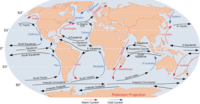
Photo from wikipedia
Mixing by mesoscale eddies in the ocean plays a major role in setting the distribution of oceanic tracers, with important implications for physical and biochemical systems at local to global… Click to show full abstract
Mixing by mesoscale eddies in the ocean plays a major role in setting the distribution of oceanic tracers, with important implications for physical and biochemical systems at local to global scales. Roach et al. (2016; https://doi.org/10.1002/2015JC011440) demonstrated that a two‐particle analysis of Argo trajectories produces robust estimates of horizontal mixing in the Southern Ocean. Here we extend this analysis to produce global 1° × 1° maps of eddy diffusivity at the nominal Argo parking depth of 1,000 m. We also applied this methodology to estimate surface eddy diffusivities from Global Drifter Program (GDP) surface drifters. The global mean eddy diffusivity was 543 ± 155 m2/s at 1,000 m and 2637 ± 311 m2/s at the surface, with elevated diffusivities in regions of enhanced eddy kinetic energy, such as western boundary currents and along the Antarctic Circumpolar Current. The eddy kinetic energy at the equator is high at both the surface and depth, but the eddy diffusivity is only enhanced near the surface. At depth the eddy diffusivity is strongly suppressed due to the presence of mean flow. We used our observational estimates to test the validity of an eddy diffusivity parameterization that accounts for mixing suppression in the presence of zonal mean flows. Our results indicated that this parameterization generally agrees with the directly observed eddy diffusivities in the midlatitude and high‐latitude oceans.
Journal Title: Journal of Geophysical Research
Year Published: 2018
Link to full text (if available)
Share on Social Media: Sign Up to like & get
recommendations!